Installing a gas meter in an apartment: step-by-step installation instructions
If quite recently gas meters were found only in rare apartments, now installing a gas meter has become a frequently performed procedure.This is due both to the mass gasification of apartments and private households, and to the increase in tariffs for this type of natural resource, because it is the controller that allows you to keep accurate records of the consumed blue fuel and use it economically.
Due to the relevance of such equipment, in this article we suggest that you familiarize yourself with the features of household meters, the subtleties of selection and installation rules, including the process of obtaining permits and step-by-step instructions for installing a gas meter.
The content of the article:
Construction of a household gas meter
There are many models of gas meters that differ in their dimensions, operating principle, design, purpose and other criteria.
In everyday life, membrane-type devices, also called diaphragm or chamber devices, are most often used. This type of meter was invented in Great Britain at the end of the 19th century and has been successfully used since then.

Such devices are characterized by low cost, sufficient strength and durability.The disadvantages include low throughput, but still sufficient for domestic purposes, and a rather large size.
Such natural gas meters consist of several compartments, which are separated from each other by alternately opening doors. Moreover, each element is connected to a special cross-shaped mechanism.
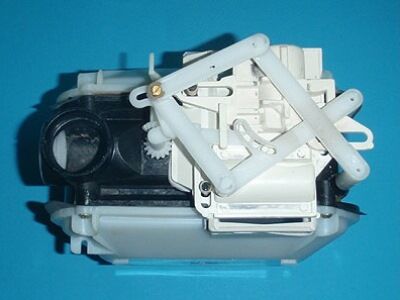
Briefly, the functioning process can be schematically represented as follows:
- Initially, gas enters the first compartment: its overflow causes deformation of the diaphragm.
- The latter sets the device’s doors in motion, which begin to open slightly in turn, allowing a certain volume of gas to penetrate into the next chamber. Immediately after the previous compartment is released, the sash closes tightly.
- The movement of the valves, allowing the next portion of gaseous fuel to pass through, gives a mechanical impulse, which sets the cross mechanism itself in motion.
- Under its influence, a special “star” device begins to rotate, which allows one to calculate how much gas flow has passed through the system.
The readings of such a counter are quite accurate.
How to choose a suitable counter?
What should you pay attention to if you decide to install a device in your house or apartment? The main criterion for choosing a device is its ability to pass a certain amount of gas through it per hour. This value can be determined independently by studying the technical parameters of all blue fuel appliances located in the apartment.
On average, a standard four-burner stove consumes 1.56 cubic meters of gas in one hour, while a gas water heater consumes 2.5 cubic meters. If both units are located in the apartment, you need to add these numbers.
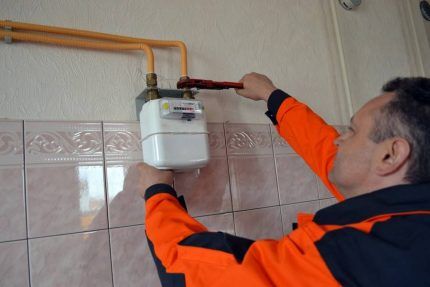
It is worth paying attention to the markings on the gasometers: it will help you understand what parameters the device is designed for.
The letters and numbers printed on the model indicate:
- G1.6 indicates that the device passes 1.6-2.5 cubic meters of gas per hour;
- G2.5 – from 2.5 to 4 cubic meters;
- G4 – from 4 to 6 cubic meters.
There are also more powerful controller options (G10 or G16), the characteristics of which are calculated according to the same principle.
When choosing a device, you should also consider the following factors:
- number of people living in the house;
- the ambient temperature at which the meter will operate - if the device is planned to be used outdoors, it is advisable to purchase devices with temperature compensators that can be used even in cold weather;
- diameter of the thread provided at the gasometer outlets;
- distance between the centers of the controller outputs.
Gas pipes come in 1/2 inch, 3/4 inch and 1 inch sizes. The first option is accepted in apartments, but can also be used in private houses, where other elements are also used.
The purchase of a gas meter must be agreed upon with the specialists who will install the device. To do this, you should contact the selected company for consultation, having previously determined the approximate power and sketched out a floor plan.
We have provided detailed recommendations for choosing the best gas meter in the next article.
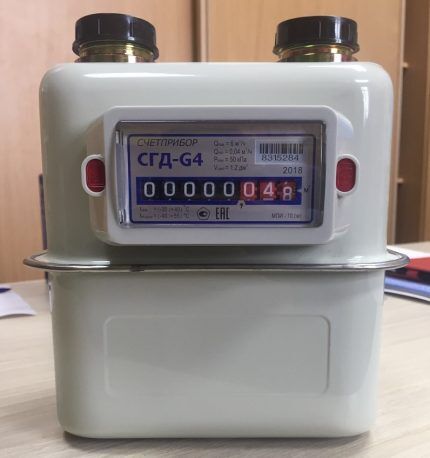
When purchasing, you should pay attention to the exact manufacturing time of the purchased meter, since the period for checking the device is determined not by the day of purchase or installation, but by the date of release.
Features of installation of a gas meter
Since gas controllers belong to the category of high-risk devices, they should only be installed by specialists who have passed the appropriate certification.
Stage #1 - choosing a service provider
In the Government Decree RF No. 410 dated 05/14/13 a circle of organizations has been determined that are allowed to carry out work with gas equipment (installation, repair, replacement). These include companies that transport fossil fuels to the network interconnection point.
Before contacting a specialized organization, try to find out the following information:
- Does the installation company have permission to carry out work related to gas networks?
- What experience does the organization have in this area? How long has she been doing this kind of work?
- What guarantees apply to the installation of gas equipment?
When choosing a contractor, you should not focus only on the low cost of the work. You should be wary of low prices for services: this may indicate insufficient qualifications of employees or the use of cheap materials of poor quality.
Stage #2 - submitting an application for installation of a gas meter
Information about the gas service can be easily found by using the gas payment receipt, on the back of which there is usually the telephone number of the relevant organization. By calling the specified number, you can consult with a specialist, find out from him the address of the gas supply service, as well as the work schedule.
After this, you should visit the selected company to submit an application for installation of a gas meter in an apartment or house.
In this case, you need to take with you the following documents:
- Russian passport;
- a certificate of ownership of housing or a rental agreement;
- a paid receipt for gas, certifying the absence of debts.
Since service employees may ask you to attach copies of documents to your application, it is better to make them in advance.
Stage #3 - installation of a gas meter and payment for work
The company's employees will explain in detail how you can install a household gas meter in a house or apartment, and after receiving the application, they will set a time for the technician's visit. He will determine the technical capabilities of installing the equipment, as well as make all the necessary measurements.
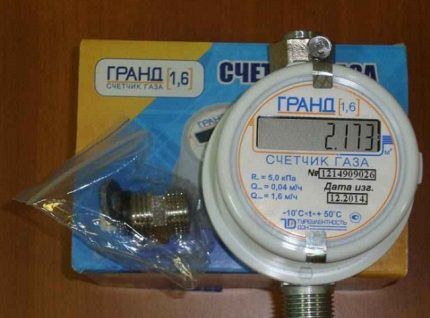
According to the expert’s conclusion and the measurements he has taken, an estimate will be drawn up and equipment will be purchased, including a gas meter suitable for the given room.
After this, the client needs to visit the gas service again to agree on the time for further work, as well as make full or partial payment.
Stage #4 - choosing a location for the device
The installation location is usually discussed with the master, who can offer his own placement option. But he should not insist on it if the owner’s choice does not violate the key provisions of the rules for installing a household gas meter in an apartment, which are regulated in SNiP 42-01-2002 And SP 42-101-2003.
According to the latest document, their placement is carried out based on the conditions of comfortable operation (installation, maintenance, repair). The gas metering controller is usually installed in the room where the gas stove, gas boiler or other equipment is located.
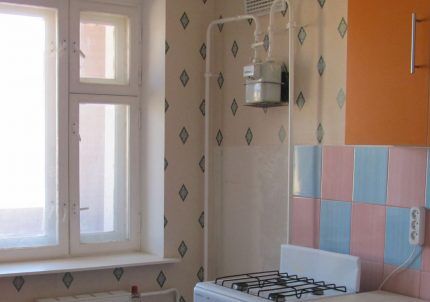
The meter can also be mounted in a space adjacent to a gasified one, even if there is an opening between them, whereas the presence of a niche is unacceptable. The device can also be installed outside the building, but in this case it is advisable to hide it under a canopy or in a special box to protect it from external influences.
The meter should be located at a distance of no more than 0.8-1 meters from the unit that consumes blue fuel (dispenser, stove, boiler). There is also a standardized height for placing the gasometer - 1.6 m.
The gas device should be separated from the wall by 3-5 cm to ensure anti-corrosion and sound protection. The shut-off valve is placed on the side of the stove at a distance of no more than two meters. If the top routing is provided, this part must be on the descent.
The gas metering device must be visible; it is advisable not to cover it with interior items.
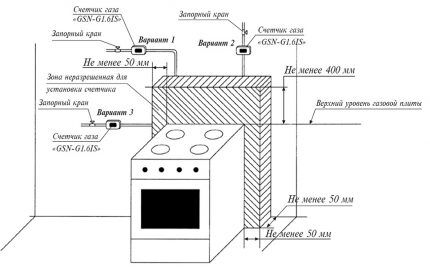
The meter should not be located directly above a sink or in other places with high humidity. The section of pipe to and from the gas pipeline should not have a slope towards the gas meter.
In addition, the room in which the gas metering device will be located must have good natural or forced ventilation.
Stage #5 - installation of the device
On the appointed day and time, the company’s repair employees come to you and must carry out all the manipulations.
A wide variety of elements are used for installation. First of all, this is a mechanical or electronic gas meter (you can use different models, including a number of foreign ones). Before installation, you must carefully inspect the appearance of the device for defects and damage.
There are some other components. Next we will discuss them in more detail.
Thermal shut-off valve (TZ)
A special feature of this element is its ability to automatically shut off the gas flow to household appliances in the event of a rise in temperature. The part consists of a body, inside of which there is a spring-loaded locking element, held open by a fusible insert.
As soon as the valve temperature reaches 90°-98° C, the insert melts, causing the element to collapse, blocking the gas flow.
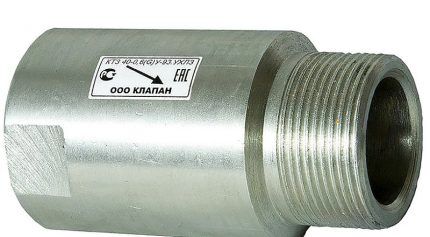
Gas valve for mechanical shut-off
A familiar part is used to mechanically shut off gas access.Household gas taps, which are usually made of brass, are designed for use on low pressure gas pipelines (up to 5 bar).
The range of manufacturers includes many models, distinguished by control methods (“handle”, “butterfly”), sizes and connection options (nut-fitting, nut-nut). Therefore, even if it is necessary to perform a replacement, choosing the right faucet will not be difficult. The main thing in the process of replacing this component is not to ignore safety regulations.
Insulating connection (IC)
A device designed for dielectric sectioning of a pipeline. In a similar way, the system is divided into connecting sections, between which the flow of electric current is prevented.
Insulating connections can be used for above-ground and underground gas pipelines. Their use helps reduce the likelihood of failure of measuring equipment due to electrical discharges resulting from various reasons.
Gas hose (bellows connection)
The flexible part is used to connect gas appliances (dispensers, stoves) to the gas pipeline. Moreover, these tasks are often performed by the users themselves without the involvement of a gas service representative. If you want to replace the hose yourself, we recommend that you familiarize yourself with rules carrying out installation work.
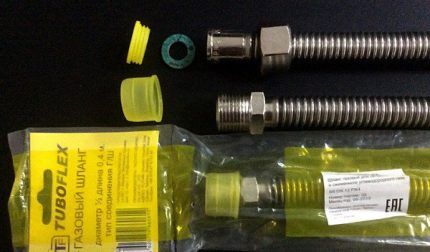
In practice, various options can be used for installing the meter hoses and liners: from conventional rubber elements to corrugated stainless steel parts with extremely high strength.
Installation specialists must ensure that the threads of the cap nuts and meter fittings match. When performing work, you must pay attention to the direction of the arrows marked on the body of the parts.
The sealing ring of the fitting can only be used once, and paronite should be used for it PON-2.0 (GOST 491-ЗС) or oil and petrol resistant rubber 1-2 mm (GOST 7338-65).
How does commissioning take place?
After installation, gas service specialists must check the functionality of the meter.
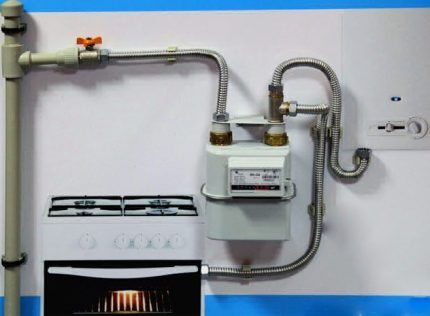
The following factors are taken into account:
- the presence of interference during the passage of fuel through the mechanisms of the device;
- counter performance;
- no gas leaks.
In addition, fuel consumption is measured.
Upon completion of control activities, a report on the work performed is drawn up, which indicates the following data:
- place and date of installation;
- gasometer serial number;
- Full name and contact details of the employees who carried out the installation;
- device performance at the time of installation;
- time of scheduled verification of the gas controller;
- smooth running of the meter's star mechanism.
The document is drawn up in two copies: one is issued to the apartment owner, the other is transferred to the gas service. The client also signs an acceptance certificate for the work performed (also in two copies). The specialist is required to fill out the device commissioning certificate and the gas meter maintenance agreement (such papers must be drawn up in triplicate).
When turning on a newly installed device, it is important to expel the air from the system using gas. To do this, you need to sequentially open the gas at the inlet and then at the outlet, which will avoid damage to the gasometer mechanism from the shock load during the first use.
Sealing and checking the meter
The final stage of installing the meter is applying a seal and brand to the mounted device. To do this, the owner must purchase a seal and again call a Gorgaz employee, who is obliged to visit the house within 5 days from the date of the application.
The specialist needs to make sure that the layout of the gas meter is correct, after which, based on the application for installation of the meter and documents on the completion of installation work, the device should be sealed. Without such an operation, the device is considered illegal, and its readings are not accepted for payment for natural fuel supplies.
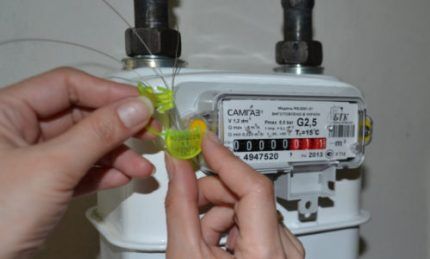
After completing all the procedures, the owner of the living space must visit the HOA (HOA), where one of the copies of the commissioning act is transferred. On its basis, an agreement is concluded with the management company to pay for gas according to the meter readings. From now on, once a month the subscriber is obliged to report meter readings to the IRC, from where a receipt will be sent with figures for the actual consumption of natural resources.
According to Russian legislation, a gas metering device must undergo initial verification before commissioning or upon completion of repair work, about which a corresponding entry is made in the technical passport of the device.
The date of the next similar event is entered in the same document. In this case, the owner of the property undertakes to ensure that checks on time.
Installation and Operation Requirements
When installing and operating gas equipment, the following points should be taken into account:
- The temperature of the incoming fuel, as well as the air temperature in the room, should be in the range from -20 to +60 OWITH.
- The model must withstand a short-term increase in fuel flow by 1/5, as well as a short-term increase in pressure by 1/10.
- The installation location of the meter must comply with the design documentation approved by the gas service.
- In an apartment building, gas welding work should be carried out only after the gas has been completely turned off in the entire entrance.
- When performing installation work on gas supply pipelines, it is necessary to first close the shut-off device and secure it from accidental opening.
- Before disconnecting steel parts, as well as installing the meter, it is necessary to bridge the disconnect points with a flexible insulated cable with a cross-section of 16 mm2, which will protect the circuit from electrostatic voltage.
- When installing equipment, you should use only certified devices and high-quality materials.
And once again the main rule: work can only be carried out by certified gas service specialists. All installation operations of gas equipment must be carried out in compliance with strict operating rules.
Cost of installation services
Since the gas flow controller device is considered the property of the apartment owner, he is obliged to purchase it at his own expense, as well as reimburse the costs of its installation.
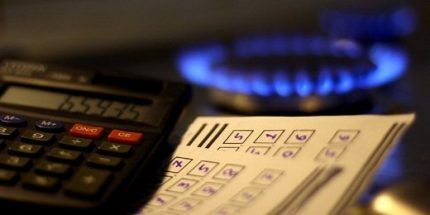
The cost of installation may vary, since this value is influenced by a number of factors, namely:
- the presence of household appliances and devices that require blue fuel to function. These include a gas water heater, water heater, gas stove, boiler;
- carrying out welding work or lack thereof;
- the length of the pipes on which the meter is mounted;
- payment for materials and equipment (hoses, fittings).
At the moment, connecting the device in a room where there is only a gas stove costs on average 3000-5000 rubles, but if the apartment is equipped with a gas water heater or other equipment, the price approximately doubles.
As practice shows, the funds spent on purchasing the device and its installation pay off within one year. But it’s still better to make an initial calculation, especially if 1-2 people live in the apartment, and the only appliances are a hob.
Conclusions and useful video on the topic
We present to your attention a video that details the procedure for installing a gas meter with the help of gas service specialists.
A correctly selected and correctly installed gas meter will bring great benefits to apartment owners. It will show the exact consumption of a natural resource, which will help monitor its consumption.
A reasonable attitude towards the use of gas, in turn, will allow you to avoid unnecessary expenses and significantly reduce the cost of paying for blue fuel.
Do you have questions that we did not cover in this material? Ask them in the comments block - our experts will try to clarify all the points.
If you want to share your personal experience in obtaining the necessary documents and installing the meter, including further design of the device and putting it into operation, please tell us about it under our article. Add a photo of your meter, indicate how quickly in your case the investment in installing the device paid off and whether you are satisfied with the result.




Why in our village do employees of the service responsible for installing gas meters insist on installing them on the street? But at the same time they cannot give a single argument to substantiate their demands. Is there any regulatory documentation regulating the installation of such meters, including the place where the measuring instruments should be located?
They have the right to insist if in your contract, which you have already signed, you undertake to do this. And they insist simply because it will be easier for Mezhregiongaz employees to take meter readings when they are located on the street.
The installation of gas meters is regulated by SP 42-101-2003. Specifically, we are interested in paragraph 6.45, which lists the places where the meter can be installed:
«– in a gasified room;
– in a non-residential premises of a gasified residential building that has natural ventilation;
– in a production building and boiler room adjacent to the gasified room and connected to it by an open opening;
– in GRP, ShRP, GRPB;
- outside the building.»
They may also oblige you if your home does not have conditions that comply with legislative acts that allow the installation of such a device. So you can insist on installing the device indoors.
@, take advantage of the fact that they are a monopoly, a gas water heater and a stove for cooking, you need to install a meter for each, 2 meters are 5000 rubles and installation of each from 12000 rubles + payment of entertainment expenses! I still have the audacity to say that it’s profitable for me when I paid 200 rubles a month, and now I’ll pay 40,000 at a time for installation and if it breaks, repairs are at my expense, and I also have to let
home inspectors, every six months - during a pandemic, wearing dirty shoes, without masks and gloves.
We have a Khrushchev-era apartment with a gas stove, which cannot be replaced with an electric one. At least that's what gas workers say. The cost of services is constantly rising, so we had to install a meter. After a couple of months, we began to feel the savings. In general, the thing is not only convenient, but also necessary. Only the issue of installing an electric stove has not disappeared. Maybe someone has more accurate information?
I wonder how the gas workers explained the impossibility of replacing a gas stove with an electric one? I know that power engineers may refuse due to the technical impossibility of increasing the power of the power grid. Plus, the redevelopment needs to be approved by the administration. Gas workers have no direct influence on any of this. So I think you were deceived.
On the other hand, there are a lot of problems with replacement. Perhaps installing a gas meter is the best solution.
Hello.We own it and don’t quite understand why you are asking the gas workers for permission... If the load power in the entire apartment building allows it, write an application to the gas distribution center, turn off the gas stove and install an electric one. But the first thing you need to do is visit the management company, Gorelektroset and coordinate the reorganization. Otherwise, turn off the gas, and the new wiring will not allow you.
What are the standards and requirements for installing a gas meter on two devices? I have a 4-burner gas stove and instantaneous water heater. Local gas workers insist on one large or two small ones for each appliance. They refuse to install a small meter with characteristic G4.
The fact is that installing two gas meters in an apartment or house does not contradict current legislation. This can be easily implemented if:
— the gas meter must be in the state register of measuring instruments;
— the gas meter is in working condition.
Also, according to the “Rules for the supply of gas to meet the household needs of citizens” (approved by Decree of the Government of the Russian Federation of July 21, 2008 No. 549), do not forget to undergo verification on time. As you can see, there are no special requirements, but for the installation of one meter you will have to pay about 4 thousand rubles. (the service itself does not include consumables). In your case, the amount is multiplied by two.
As for G4 meters, there are many varieties, what is the specific model? Is it on the registry? Check it out! If yes, then they have no right to refuse installation.
Hello, gas workers refused to change the gas meter due to the fact that our pipes are protected in a box. The meter itself is accessible, the window is cut out.Are their actions legal? What rules and regulations apply in this case regarding the disposal of gas pipelines?
Hello, Yuri. Now I'm surprised. SP 62.13330.2011 clause 7.10. "Each facility where gas-using equipment is installed must be equipped with a unified gas metering unit in accordance with the regulatory legal documents of the Russian Federation.«.
G4 should allow the connection of a 4-burner stove and a water heater. Can't you fit into 4 cubes? Make a calculation, provide it to the gas company, and if the maximum gas consumption allows, demand a written justification for refusing to connect.
Hello, we live in the Samara region of the Kuibyshev district, for installing a meter, my mother was charged 9000 - is this normal? SVGK company.
Don't take it as sarcasm, but this is a normal price, alas. I judge from Tula, where as of June 23, 2018, according to official data from JSC Gazprom Gazoraspredeleniye Tula, the service of installing a meter in an apartment or house (without reinstalling the gas pipeline, the cost of materials and equipment) costs 4,123 rubles. Add here the cost of a regular household gas meter of at least 2 thousand rubles, then the amount will already be over 6 thousand rubles. And this does not include consumables.
So the price tag is 9 thousand rubles. does not look exorbitant considering the cost of the installation service itself. What does it say on your receipt? Was it your meter or did the gas workers bring it?
It depends on many factors and you should look at the detailed price list from the receipt. But, by the way, SVGK received the following warning (admittedly 2 years ago, but it may still be relevant now):
«Dear subscribers! Due to the increasing number of requests/complaints related to violations of consumer rights, misrepresentation during the installation of gas meters (GMU), and the sale of gas alarms at an inflated price, we ask that when providing you with such “services” on behalf of the gas supplier, from persons pretending to be “gas workers”, employees of a “gas company” and the like, it is mandatory to check the credentials of the above-mentioned persons.
Be careful! Remember that we do not go door to door and do not impose, under threat of fines, “at a discount for pensioners,” the installation of meters or other devices! We have nothing to do with these people, their devices and “services”. Please note: according to Federal Law No. 261-FZ “On Energy Saving”, apartment owners who have only gas stoves are not required to install gas meters.
SVGK LLC is not responsible for the consequences of the actions of third-party organizations/individuals, such as breaking the seal on the meter, poor-quality installation of the meter, technically unjustified installation of a gas alarm, etc.
If you have any questions/doubts when communicating with gas company employees, we recommend contacting SVGK LLC, or the gas service maintenance and repair site at your place of residence. Single contact phone number 8-(846)-340-61-61 or 8-800-707-65-55.
»Question for you - did you receive receipts for the work done? Are you sure that SVGK employees came to you and checked your ID? Is this the first time the meter has been installed?
If the installation height of the meter provided for by the project is 1.6 m, is it possible to change this height?
Hello.You can change the height, installation location and the meter itself, if your actions are not unauthorized or unacceptable. Submit an application to the GRO, make the appropriate changes to the project, wait for specialists to transfer it, then installation, sealing, contract and that’s it.
There are recommended standards, and a height of 1.6 m is exactly that. But as a rule, this is not an ironclad argument. SP 42-101-2003 General provisions for the design and construction of gas distribution systems - this is the document.
But SP 402.1325800.2018 Residential buildings. Rules for designing gas consumption systems: “The installation height of wall-mounted equipment should be convenient for operation and repair«.
you quote cp.402.1325800.2018 clause 5.12 which talks about GAS USING equipment - “the installation height of wall-mounted equipment should be convenient for operation and repair” and this does not apply to meters.
Here is a point that talks about the installation height of the meter:
5.14 Each facility where gas-using equipment is installed must be equipped with a gas metering unit in accordance with the current legislation of the Russian Federation. Installation of gas metering units should be carried out in accordance with Appendix B.
Appendix B
Placement of gas metering units and installation of shut-off valves
B.3 Installation of meters is provided based on the conditions of ease of installation, maintenance and repair. The installation height of the meters should be from 1.1 to 1.6 m from the floor level of the room or ground.
I think that's right. comment...
Hello, is there any installation drawing like installation example? I would like to be able to select materials in advance and understand what equipment should be there.
Or you can, for example, turn to specialists not from GorGaz, but from a private office that installs gas meters. But after installing the device, you will still need to call a representative of the company with which contract signed for gas supply and maintenance of equipment consuming it. They must seal the flow meter.
My meter is located in a room adjacent to the one in which the gas equipment is located. Installed in a decorative box, the gas workers told me to remove the box. I understand that this is for meter ventilation. Is it possible to leave the box, but add ventilation holes in the box?
I’m going to check the gas meter, the raygas workers are forcing me to sign a replacement (repair) agreement and pay for maintenance. work (dismantling and installation), but this is not 100 rubles (1100). I rely on Government Resolution 824 of September 19, 2013. Do they have the right to demand payment from me in this case?
Is it possible to deviate from the normalized height of the meter (model Grand 4). The article indicates a figure of 1.6 m. I want to raise it to a height of 2.3-2.5m so that it is hidden above the upper kitchen cabinets. It's not difficult to go there once a month. The apartment is small - a studio and every cm counts. The photo shows the result that the gas workers did without my consent. I drew how I would like to make them redo it. Perhaps so?
Hello. If the apartment has a gas meter...You can refuse it, dismantle it and make payment according to the standard. In what documents is this stated so that you can legally influence the dismantling of the meter? Thank you.
you quote cp.402.1325800.2018 clause 5.12 which talks about GAS USING equipment - “the installation height of wall-mounted equipment should be convenient for operation and repair” and this does not apply to meters.
Here is a point that talks about the installation height of the meter:
5.14 Each facility where gas-using equipment is installed must be equipped with a gas metering unit in accordance with the current legislation of the Russian Federation. Installation of gas metering units should be carried out in accordance with Appendix B.
Appendix B
Placement of gas metering units and installation of shut-off valves
B.3 Installation of meters is provided based on the conditions of ease of installation, maintenance and repair. The installation height of the meters should be from 1.1 to 1.6 m from the floor level of the room or ground.
I think that's right. comment...
Hello,
Just yesterday, a gas company foreman installed a left-handed gas meter in my yard, when my line runs right-handed, and in response to my protests, he said, “It’s okay, everything is fine, the main thing is that you have gas.” See the attached pictures, where the gas pipes before and after the meter are welded to each other. Is this an installation violation or not? What should I do? And it doesn't look aesthetically pleasing. Unfortunately, comments with photos are not sent.
Hello,
Just yesterday, a gas company foreman installed a gas meter in the yard with a left-hand direction when the direction goes from the right-hand side. And where the pipes intersect, it is welded to each other. (I can't attach a photo). Is this an installation violation or not? What should I do? And it doesn't look aesthetically pleasing. Then on the part of the controllers there will be no doubt that the gas can bypass the meter, through this welded place? Please answer if anyone knows the installation rules or has encountered a similar situation.